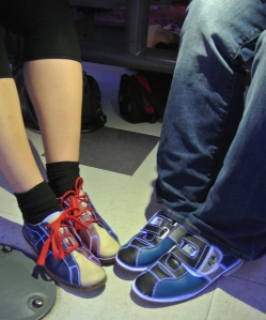The worthy specimens featured in today’s post were recently spotted on the feet of Photo Researcher Erica Johnson (left) and Production Editor Sarah Olmanson (right) at one of our local bowling hotspots. (It’s true, we do have actual bowling hotspots here. They’re often full of hipsters.) Notice the varying styles—the traditional laces vs. the newfangled Velcro. And now, as I am often wont to do, I’ll taking what should be a relatively simple thing, a post about bowling shoes, and turn it into something more complicated—tradition and technology.
Pondering the changing style of bowling shoes led me to reminiscing of my time in the kid’s bowling league in the 80s when I surely wore rent-a-shoes from the 70s. That thought veered into wondering if Lerner had ever published a book on bowling. As it is fun to venture into the archives of a 53-year old publishing company, I did just that. And so bring you:
We have, indeed, published a book on bowling. In the tradition of Lerner, Bowling Is for Me is a solid, informational introduction to the game of bowling written in a manner kids can relate to. But as you can see, it does have a slight air of what I shall deem pre-computer layout frugality with an early 80s aesthetic. Aesthetics and technology around the publishing industry have changed much in the past 30-odd years since this book was published. Technology is ever-changing, but the basics of making good content do not change.
Back to bowling, a game you may think technology doesn’t affect so much. Take another look, past the Velcro shoes. Even past the black light and the computerized scoring. Anyone else out there miss the hot projected plastic sheet manual scoring? Lane surfaces are synthetic instead of old-fashioned wood and balls are made of reactive resin (which means the ball grabs the lane better at the end for a harder hook into the pocket), both advances that have possibly made bowling strikes—and therefore the elusive 300 game—easier. If you don’t have the latest tech in bowling, you’ll fall behind the competition. But still, even with new tech, you need to know bowling technique and to do the work of learning the traditional game to make the technology work to your advantage.
Technology in publishing seems to advance almost daily. Is this making books easier to make? In some ways, yes. It’s easier to contact authors, photographers, artists, or researchers, so our scope of talent is wider and ever growing. Even four years ago hiring an illustrator from a different continent had a lot of logistical problems—now (apart from language-related miscommunications) it’s easy. Don’t live in D.C. to visit the photo archives constantly in person? They’re online! Is the indexer off to live in Peru for a couple of months? No problem! (As long as the indexer has a laptop and can find an occasional internet signal.) Production times have lessened considerably, and with more flexible results as content moves from print to product types starting with an ‘i’ or ‘e’. Advancing tech though, however helpful, is not a substitute for knowledge, work, and talent. Publishing professionals still need the same skills they’ve always needed. Creativity, thoughtfulness, problem-solving, and the ability to research are still essential for good content. The TECH doesn’t do that on its own. It merely helps products get made and distributed.
And so I leave you with this: embrace the new technologies out there. But do so creatively, in a way that remains true to the original idea, whether it be in sport or book publishing. A solid foundation and mastering the basics is irreplaceable.


